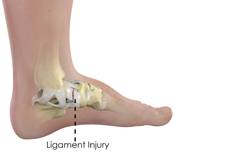Soft Tissue Injury or Abnormality

Ligament
A sprain is stretching or tearing of a ligament. Ligaments connect adjacent bones in a joint and provide stability to the joint.An ankle sprain is a common injury and occurs when you fall or suddenly twist the ankle joint or when you land your foot in an awkward position after a jump.
General Tendon Injury

Tendonitis
Tendonitis refers to the inflammation of a tendon, which is a band of fibrous connective tissue that attaches a muscle to a bone. Tendinitis can result from repetitive or overuse injury of the tendon and can occur during activities such as gardening, carpentry, shoveling, painting, scrubbing, tennis, golf, skiing, and pitching.

Tear
The anterior cruciate ligament, or ACL, is one of the major ligaments of the knee that is located in the middle of the knee and runs from the femur (thigh bone) to the tibia (shin bone). It prevents the tibia from sliding out in front of the femur.

Achilles Tendon Rupture
Achilles tendon is a strong fibrous cord present behind the ankle that connects the calf muscles to heel bone. It is used when you walk, run and jump. When the Achilles tendon becomes thin, weak, or if it is not used, it may be susceptible to injury or damage.

Plantar Fasciitis
Plantar fasciitis refers to inflammation of the plantar fascia, a thick band of tissue that lies at the bottom of the foot. It runs from the heel bone to the toe and forms the arch of your foot. Plantar fasciitis is one of the most common painful foot conditions. It is most often seen in middle-aged men and women.

Morton’s Neuroma
Morton’s neuroma refers to a nerve injury between the toes, usually the third and fourth toes, which causes pain and thickening of the nerve tissue. Compression or chronic irritation of this interdigital nerve is the main cause of Morton’s Neuroma.
Intra-articular Injury or Abnormality

Cartilage Restoration
Articular Cartilage is the white tissue lining the end of bones where these bones connect to form joints. Cartilage acts as cushioning material and helps in smooth gliding of bones during movement. An injury to the joint may damage this cartilage which cannot repair on its own. Cartilage can be damaged with increasing age, normal wear and tear, or trauma.

Osteochondral Injury
Osteochondral injuries are one of the most common causes of ankle pain. Though in a majority of cases there is a history of injury or trauma to the ankle joint, a few cases may not have any previous history of ankle injury. A condition known as osteochondritis dissecans is commonly seen in the knee and ankle joint and is characterized by the damage and separation of a piece of bone and cartilage, within the joint, from the underlying bone.

Loose Body
Loose bodies are small loose fragments of cartilage or a bone that float around the joint. The loose bodies can cause pain, swelling, locking and catching of the joint. Loose bodies occur if there is bleeding within the joint, death of tissueslining the joints associated with tuberculosis, osteoarthritis and rheumatoid arthritis.

Degenerative Disease
Arthritis is inflammation resulting from the degeneration of cartilage in the joint causing pain, swelling, and stiffness in the joints resulting in restricted movements. Arthritis of the foot and ankle joint can occur due to fracture, dislocation, inflammatory disease, or congenital deformity.
Trauma

Ankle Fracture
Ankle injuries are the most common sports-related injury. An ankle fracture is a break in one or more bones that make up the ankle joint. Sometimes ligaments may also be damaged.

Foot Fractures
A stress fracture is described as a small crack in the bone which occurs from an overuse injury of a bone. It commonly develops in the weight bearing bones of the lower leg and foot. When the muscles of the foot are overworked or stressed, they are unable to absorb the stress









